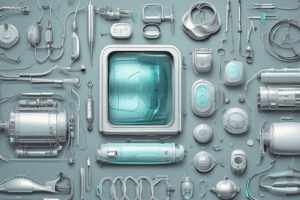Podcast
Questions and Answers
What is the primary purpose of sealing peel-apart pouches?
What is the primary purpose of sealing peel-apart pouches?
- To provide a transparent plastic film for visibility
- To ensure the product remains sterile after autoclaving (correct)
- To allow for fast and easy packing of small lightweight instruments
- To facilitate easy identification of the packed instrument
What type of pouch is used for Steam and Ethylene Oxide sterilization methods?
What type of pouch is used for Steam and Ethylene Oxide sterilization methods?
- Paper pouch (correct)
- Plastic pouch
- Tyvek pouch
- Kraft244 type paper/plastic pouch
What is the purpose of leaving ¼’’ space on each side of the package?
What is the purpose of leaving ¼’’ space on each side of the package?
- To ensure complete sterilant contact to surfaces of the surgical instruments
- To prevent package rupture during sterilization
- To allow for easy identification of the packed instrument
- To facilitate air removal and sterilant penetration (correct)
Why is it important to remove excessive air from the pouch before sealing?
Why is it important to remove excessive air from the pouch before sealing?
What type of pouch is used when sterilizing instruments by hydrogen peroxide?
What type of pouch is used when sterilizing instruments by hydrogen peroxide?
What is the purpose of heat sealing or self-adhesive sealing?
What is the purpose of heat sealing or self-adhesive sealing?
What is the recommended method for labeling pouches?
What is the recommended method for labeling pouches?
What is the purpose of using a heat sealer or self-seal?
What is the purpose of using a heat sealer or self-seal?
What is the advantage of using see-through peel packaging?
What is the advantage of using see-through peel packaging?
How are peel pouches available for use?
How are peel pouches available for use?
Flashcards are hidden until you start studying
Study Notes
Assembling Devices into Trays
- Devices are arranged from left to right in the order they will be used in a procedure.
- Devices can also be arranged by size to prevent tangling.
- A checklist should be used to ensure consistency and accuracy.
- All contents of a surgical instrument tray must be checked and verified against the checklist.
Preparing Devices for Sterilization
- Forceps should be placed on instrument pins to hold them together and reduce tangling.
- Follow the manufacturer's instructions for devices that require special sterilization or disassembly.
- Leave forceps with ratchets open, or close them on the first ratchet only, to ensure steam penetration.
- Spread devices evenly over the tray surface to prevent condensate from flowing together.
- Place plastic items evenly in the tray, avoiding collection in one area.
- Use validated tip protectors and tray liners or silicone mats to protect delicate devices.
Packaging Devices for Sterilization
- The type of packaging material and technique used depends on the items to be packaged and the sterilization process.
- Packaging materials must provide an effective barrier to microbial penetration, protect devices from contamination, and allow aseptic delivery.
- Common packaging materials include rigid containers, peel pouches, and sterilization wraps.
- Sterilization wraps are the most commonly used method.
Sterilization Wrap Techniques
- Sequential wrapping involves wrapping two layers of wrap material individually using a fold technique.
- Simultaneous wrapping involves wrapping both layers together simultaneously.
- Square fold and envelope fold techniques are used with sequential and simultaneous wrapping methods.
Containers and Peel Pouches
- Rigid reusable containers are making a comeback due to improved technology and cost-effectiveness.
- Peel-apart pouches are used to pack small lightweight single instruments.
- The type of pouch used depends on the sterilization method being used.
- Peel pouches can be made of medical-grade paper/plastic or spunbond polyolefin-plastic (Tyvek).
- The choice of pouch material depends on the sterilization method used.
- Pouches should be sealed carefully, and the identification of packed devices should be easy due to the transparent plastic film.
Studying That Suits You
Use AI to generate personalized quizzes and flashcards to suit your learning preferences.




